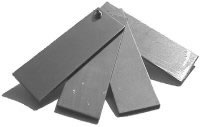|
Stainless Steel is manditory for Wall Ties Steel Lintels, wall ties, and masonry supports are relatively modern construction practice, Wall ties were once galvanised, following the discovery that they could completely distintegrate within a few decades, stainless steel has been made manditory and wall tie replacement is now it's own industry. |
|
|
||||||
|
Lintels are installed in the same environment Obviously steel lintels have more material, but they are similar thickness. |
||||||||
|
Comparing corrosion performance of Stainless Steels There are several different types of corrosion in steels, but in all cases LDX 2101 Stainless Steel outperforms grade 304 Stainless Steel. In some cases, LDX 2101 outperforms grade 316 Stainless Steel. |
 |
|||||||
We know from decades of experience that grade 304 stainless stainless steel performs admirably in building exteriors, so we need to satisfy ourselves that the new LDX 2101 duplex performs similarly well. See below for a range of standard laboratory corrosion tests: |
||||||||
|
Uniform Corrosion Resistance Test >> The ISO general corrosion test involves the application of a hydrochloric acid solution. The results (together with the pitting result) give a relative indication of how the different metals are likely to perform under typical open atmospheric corrosion conditions. |
|
|||||||
|
Pitting / Crevice Corrosion test >> Pitting and crevice corrosion are similar corrosion mechanisms, resistance can be predicted using the Pitting Resistance Equivalent Number (PREN) which takes into consideration to proportions of Chromium, Molybdenum & Nitrigen in the alloy (details are in the technical pages of our catalogue). These predictions have proven approximately correct to the ASTM G 150 Avesta Cell proceedure to determine critical pitting termperature. |
|
|||||||
|
Stress Corrosion Cracking >> Stressed or worked areas of stainless steel can prove weak points for corrosion resistance. In short, this is tested by immersing a U-bend of steel in a CaCl solution at 100degrees C and measuring the time until stress corrosion cracks appear. The grain structure of the steel has strong influence on this result. |
|
|||||||
|
Intergranular Corrosion >> Is a corrosion condition where the boundries of the grain structure are more suseptible to corrosion and corrode first. This is due to Chromium Carbide precipitation during slow cooling. SS37 and LDX 2101 have lower carbon contents that the Austenitic stainless steels and are thus less susceptible to intergranular corrosion. This can result from the mill process or welding procedures, but in our case, all materials are relatively light gauge and thus cool rapidly, minimising carbide precipitation. |
|
|||||||